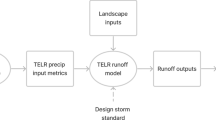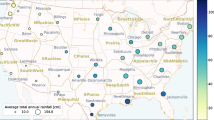Abstract
The design of stormwater infrastructure is based on an underlying assumption that the probability distribution of precipitation extremes is statistically stationary. This assumption is called into question by climate change, resulting in uncertainty about the future performance of systems constructed under this paradigm. We therefore examined both historical precipitation records and simulations of future rainfall to evaluate past and prospective changes in the probability distributions of precipitation extremes across Washington State. Our historical analyses were based on hourly precipitation records for the time period 1949–2007 from weather stations in and near the state’s three major metropolitan areas: the Puget Sound region, Vancouver (WA), and Spokane. Changes in future precipitation were evaluated using two runs of the Weather Research and Forecast (WRF) regional climate model (RCM) for the time periods 1970–2000 and 2020–2050, dynamically downscaled from the ECHAM5 and CCSM3 global climate models. Bias-corrected and statistically downscaled hourly precipitation sequences were then used as input to the HSPF hydrologic model to simulate streamflow in two urban watersheds in central Puget Sound. Few statistically significant changes were observed in the historical records, with the possible exception of the Puget Sound region. Although RCM simulations generally predict increases in extreme rainfall magnitudes, the range of these projections is too large at present to provide a basis for engineering design, and can only be narrowed through consideration of a larger sample of simulated climate data. Nonetheless, the evidence suggests that drainage infrastructure designed using mid-20th century rainfall records may be subject to a future rainfall regime that differs from current design standards.
Similar content being viewed by others
References
Bicknell BR et al (1996) Hydrological Simulation Program—Fortran: User’s manual for Release 11. US Environmental Protection Agency, Environmental Research Laboratory, Office of Research and Development, Athens, Georgia
Booth DB, Jackson CR (1997) Urbanization of aquatic systems—degradation thresholds, stormwater detention, and the limits of mitigation. J Am Water Resour Assoc 33(5):1077–1090
Choguill CL (1996) Ten steps to sustainable infrastructure. Habitat Int 20(3):389–404
Denault C, Millar RJ, Lence BJ (2002) Climate change and drainage infrastructure capacity in an urban catchment. Annual conference of the Canadian Society for Civil Engineering, Montreal, Quebec, Canada
Dinicola et al (1990) Characterization and simulation of rainfall-runoff relations for headwater basins in western King and Snohomish Counties, Washington. US Geological Survey Water-Resources Investigation Report 89-4052
Dinicola et al (2001) Validation of a numerical modeling method for simulating rainfall-runoff relations for headwater basins in western King and Snohomish Counties, Washington. US Geological Survey Water-Supply Paper 2495
Efron B (1979) Bootstrap methods: another look at the jackknife. Ann Stat 7(1):1–26
Fowler HJ, Kilsby CG (2003) A regional frequency analysis of United Kingdom extreme rainfall from 1961 to 2000. Int J Climatol 23:1313–1334
Gerstel WJ, Brunengo MJ, Lingley WS Jr, Logan RL, Shipman H, Walsh TJ (1997) Puget Sound bluffs: the where, why, and when of landslides following the 1996/97 storms. Wash Geol 25(1):17–31
Groisman PY, Knight RW, Easterling DR, Karl TR, Hegerl GC, Razuvaev VN (2005) Trends in intense precipitation in the climate record. J Clim 18(9):1326–1350
Hamlet AF, Lee SY, Mickelson KEB, Elsner MM (2010) Effects of projected climate change on energy supply and demand in the Pacific Northwest and Washington State. Clim Change. doi:10.1007/s10584-010-9857-y
Hanson R (ed) (1984) Perspectives on urban infrastructure. Committee on National Urban Policy, National Research Council, Washington, DC. National Academies Press, 216 pp
Hosking JRM, Wallis JR (1997) Regional frequency analysis: an approach based on L-moments. Cambridge University Press, New York
Interagency Committee on Water Data (IACWD) (1982) Guidelines for determining flood flow frequency. Bulletin 17B (revised and corrected), Hydrology Subcommittee, Washington, DC
Intergovernmental Panel on Climate Change (IPCC) (2007a) Climate change 2007: the physical science basis. Geneva, Switzerland
Intergovernmental Panel on Climate Change (IPCC) (2007b) Climate change 2007: synthesis report. contribution of working groups I, II and III to the fourth assessment report of the Intergovernmental Panel on Climate Change [core writing team Pachauri RK, Reisinger A eds.] Geneva, Switzerland
Karl TR, Knight RW (1998) Secular trends of precipitation amount, frequency, and intensity in the United States. Bull Am Meteorol Soc 79(2):231–241
King County (1985) Juanita Creek basin plan. King County Department of Public Works, Surface Water Management Division, Seattle, Washington
Kirschen P, Ruth M, Anderson M, Lakshmanan TR (2004) Infrastructure systems, services and climate change: Integrated impacts and response strategies for the Boston metropolitan area. Tufts University: Climate’s Long-term impacts on metro Boston (CLIMB). USEPA Grant Number R.827450-01, Final report. http://www.aia.org/SiteObjects/files/CLIMB%20Executive%20Summary.pdf. Accessed 6 Dec 2008
Konrad CP, Booth DB (2002) Hydrologic trends associated with urban development for selected streams in the Puget Sound basin, western Washington. US Geological Survey Water Resources Investigations Report No. 4040
Kunkel KE, Andsager K, Easterling DR (1999) Long-term trends in extreme precipitation events over the conterminous United States and Canada. J Clim 12:2515–2527
Kunkel KE, Easterling DR, Redmond K, Hubbard K (2003) Temporal variations of extreme precipitation events in the United States: 1895–2000. Geophys Res Lett 30(17):1900
Larsen P, Goldsmith S (2007) How much might climate change add to future costs for public infrastructure? Institute of Social and Economic Research, University of Alaska Anchorage. UA Research Summary No. 8
Leopold LB (1968) Hydrology for urban land planning—a guidebook on the hydrologic effects of urban land use. Geol Surv Circ 554, 18 pp
Leung LR, Kuo YH, Tribbia J (2006) Research needs and directions of regional climate modeling using WRF and CCSM. Bull Am Meteorol Soc 87:1747–1751
Lettenmaier DP (1976) Detection of trends in water quality data with dependent observations. Water Resour Res 12(5):1037–1046
Lettenmaier DP, Wallis JR, Wood EF (1987) Effect of regional heterogeneity on flood frequency estimation. Water Resourc Res 23(2):313–324
Madsen T, Figdor E (2007) When it rains, it pours: global warming and the rising frequency of extreme precipitation in the United States. Report prepared by Environment America Research and Policy Center, Boston
Mote P, Salathé E, Peacock C (2005) Scenarios of future climate for the Pacific Northwest. Report prepared by the Climate Impacts Group, Center for Science in the Earth System, Joint Institute for the Study of the Atmosphere and Oceans, University of Washington, Seattle. http://cses.washington.edu/db/pdf/kc05scenarios462.pdf
Payne JT et al (2004) Mitigating the effects of climate change on the water resources of the Columbia River Basin. Clim Change 62(1–3):233–256
Pryor SC, Howe JA, Kunkel KE (2009) How spatially coherent and statistically robust are temporal changes in extreme precipitation in the contiguous USA? Int J Climatol 29:31–45
Richter BD, Baumgartner JV, Powell J, Braun DP (1996) A method for assessing hydrologic alteration within ecosystems. Conserv Biol 10:1163–1174
Salathé EP (2005) Downscaling simulations of future global climate with application to hydrologic modeling. Int J Climatol 25(4):419–436
Salathé EP, Steed R, Mass CF, Zahn P (2008) A high-resolution climate model for the U.S. Pacific Northwest: Mesoscale feedbacks and local responses to climate change. J Clim 21:5708–5726
Salathé EP, Leung LR, Qian Y, Zhang Y (2010) Regional climate model projections for the State of Washington. Clim Change. doi:10.1007/s10584-010-9849-y
Shaw H, Reisinger A, Larsen H, Stumbles C (2005) Incorporating climate change into stormwater design—why and how? South Pacific Conference on Stormwater and Aquatic Resource Protection, Ministry for the Environment, Auckland, New Zealand
Trenberth K, Dai A, Rasmussen RM, Parsons DB (2003) The changing character of precipitation. Bull Am Meteorol Soc 84(9):1205–1217
Urbonas BR, Roesner LA (1993) Hydrologic design for urban drainage and flood control. In: Maidment DR (ed) Handbook of hydrology. McGraw-Hill, New York
Vano JA, Voisin N, Cuo L, Hamlet AF, Elsner MM, Palmer RN, Polebitski A, Lettenmaier DP (2010a) Climate change impacts on water management in the Puget Sound region,Washington State, USA. Clim Change. doi:10.1007/s10584-010-9846-1
Vano JA, Voisin N, Scott M, Stockle CO, Hamlet AF, Mickelson KEB, Elsner MM, Lettenmaier DP (2010b) Climate change impacts on water management and irrigated agriculture in the Yakima River Basin, Washington, USA. Clim Change. doi:10.1007/s10584-010-9856-z
Wallis JR, Schaefer MG, Barker BL, Taylor GH (2007) Regional precipitation-frequency analysis and spatial mapping for 24-hour and 2-day durations for Washington State. Hydrol Earth Syst Sci 11(1):415–442
Washington State Department of Transportation (WSDOT) (2008) Storm-related closures of I-5 and I-90: Freight Transportation Economic Impact Assessment Report. Washington State Department of Transportation WA-RD 708.1
Waters D, Watt WE, Marsalek J, Anderson BC (2003) Adaptation of a storm drainage system to accommodate increased rainfall resulting from climate change. J Environ Plan Manag 46(5):755–770
Watt WE, Waters D, Mclean R (2003) Climate variability and urban stormwater infrastructure in Canada: Context and case studies. Toronto-Niagara Region Study Report and Working Paper Series, Meteorological Service of Canada, Waterloo, Ontario, Canada
Wilks DS (2006) Statistical methods in the atmospheric sciences, Second Edition. Academic Press
Wood AW, Maurer EP, Kumar A, Lettenmaier DP (2002) Long-range experimental hydrologic forecasting for the eastern United States. J Geophys Res 107(D20):4429
Author information
Authors and Affiliations
Corresponding author
Rights and permissions
About this article
Cite this article
Rosenberg, E.A., Keys, P.W., Booth, D.B. et al. Precipitation extremes and the impacts of climate change on stormwater infrastructure in Washington State. Climatic Change 102, 319–349 (2010). https://doi.org/10.1007/s10584-010-9847-0
Received:
Accepted:
Published:
Issue Date:
DOI: https://doi.org/10.1007/s10584-010-9847-0




